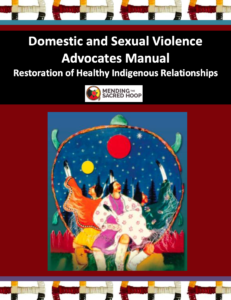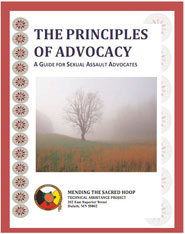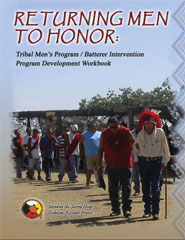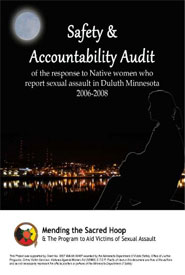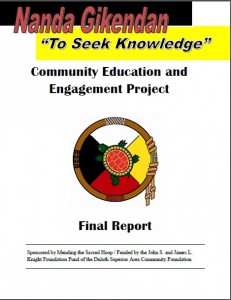Manuals
Mending the Sacred Hoop – Downloadable Resources
Addressing Domestic Violence in Indian Country
In order to end domestic violence in all its forms, we must understand why it exists in Native communities today, and assess our current challenges in addressing the issue. When we examine the reasons behind the presence of domestic violence in Native communities, we must first consider its historical origins.
Domestic violence in Native society came about over the course of centuries of change. Examining the history of oppression that laid the groundwork for the rise of violence against Native women shows us that efforts to end the domestic violence across Indian Country are past their infancy and have evolved, tightly woven between the past and 2023.
“You must be able to see where you have been,
before you can possibly know where you want to go.”
~ Muscogee Creek
A Native Woman’s Perspective on the Scope of the Problem: Sexual Assault of American Indian and Alaskan Native Women
As Native women and advocates, we know that in Native women’s support groups or talking circles our discussions inevitably move to sexual assault. From the earliest stages of childhood to the later years of life as an elder, Native women experience-in epidemic proportions-sexual assault, sexual abuse, molestation, incest, rape, as well as other forms of sexual violence. So pervasive is this experience that the in-group dialogue generally concentrates on participants supporting one another and discussing the healing process rather than the criminal justice response. As we consider the issue of sexual assault against American Indian and Alaskan Native Women, a critical thinking analysis directs us to ask, within the context of the scope of the problem, what are the common denominators for Native women that put us at the highest risk of sexual violence? In which direction must we travel to find solutions to this epidemic?
According to the U.S. Bureau of Justice Statistics’ Report on American Indians and Crime released in 1999, American Indians and Alaskan Natives experience violent crime at per capita rates that are double those of the U.S. resident population. The totality of this report exposes disturbing facts about American Indians and Alaskan Natives and crime. One of the most alarming revelations is that as Native women, we are over three times more likely to be a victim of sexual assault than women of other races.1
The epidemic of violence against Native women-particularly sexual assault-is a troubling trend that affects the health and welfare of current and future generations of women. Although research such as the BJS report is useful in exposing the gravity of violence reflected by reported crime, it is a statistical analysis that reflects only the end result of a more complex cataclysm. These statistics as they stand are staggering, but when we consider these figures in light of the fact that most sexual assaults are not reported,2 this issue becomes a crisis of epidemic proportions for Native women.
This discussion focuses specifically on sexual assault against American Indian and Alaskan Native women because it is the single most critical issue facing Indian women not being adequately addressed by the criminal justice system, tribal governments, or society as a whole. The goal is to provide a better understanding of the far-reaching impact of sexual assault against American Indian and Alaskan Native women by exploring specific elements of perceptions, policy, and other key factors in order to determine the scope of the problem. It is hoped that examining this issue from a broader perspective will bring the critical need to develop strategies that address culturally appropriate and effective responses to end the sexual assault of American Indian and Alaskan Native women to the forefront. This approach acknowledges that the complexity of sovereignty and jurisdictional barriers deserves an intense analysis, much more than can be discussed in this brief overview; however the prosecution of sexual assaults against adult Native women is vital to evaluating the scope of the problem. Jim Mancini of the Dine Bureau reports that rapes have jumped 40% on the Navajo reservation in the last three years, and describes the seriousness of ever increasing numbers of sexual assaults of Native women. Another notable fact is that sex crimes account for 70% of tribal investigators time.3 In spite of the fact that research , state and tribal agencies to provide adequate protection to Native women, law enforcement resources in Native communities lag far behind such resources in other communities. Underlying these statistics is the vital question, “Who is responsible for the safety of Native women?”
Federal Indian Policy
The capacity to protect Native women from violence in the form of sexual assault is dependent on the coordination of tribal, federal, and state responses. Amongst the many public policy protocols addressing violence against women is the focus on developing a coordinated community response, particularly within the criminal justice system. This criminal justice emphasis has made great strides taking the issue of domestic violence out of the home and into the halls of justice, criminalizing the behavior and forging partnerships between advocacy groups and law enforcement. In theory and practical application, this coordination has provided an array of options for Native women wishing to leave abusive relationships.
Sexual assault, however, continues to be an area in which the criminal justice response to violence against women is lacking-especially for Native women. This is due, in large part, to the fact that the coordination of criminal justice institutions intersecting the lives of Native people lack resources and continuity. Although significant progress has been undertaken with the establishment of the Office of Tribal Justice through the U. S. Department of Justice, funding remains insufficient to adequately address the basic needs of tribal law enforcement, tribal courts, and correctional facilities on reservations, villages, and rancherias.
As the increasing need for the administration of justice is justified through data collection and research, federal funding for Native programming has not kept pace-in fact, it has lagged grossly behind in providing adequate resources. According to recent research conducted by the U. S. Commission on Civil Rights, funding for Native programming has remained at an increase of 1 percent for the last six years (between 1998 and 2004). Additionally, during the period of 2002 – 2003, funding for Native programs decreased by 14 percent. 5 These statistics demonstrate a key contributing factor to the prevalence of violent crime against Native women-tribes are inadequately
Building a Coordinated Community Response in Native Communities
This manual was created to specifically outline the process of building a Coordinated Community Response (CCR) in Native communities. A CCR, simply stated, is a monitoring and tracking system that establishes women’s safety by focusing on batterers and their activity. This is done through a multi-agency collaboration with individuals dedicated to developing a response to domestic violence by implementing policies and practices to ensure batterer accountability. Each agency develops a role within this collaboration, ensuring a consistent response from law enforcement, prosecutors, judges and probation officers.
The many complex jurisdictional and legal issues that exist in Indian country make it difficult to pose a single organizing model that is relevant to all Native communities. This manual separates the creation of building a Coordinated Community Response into a framework for general use, suggesting ways to customize this practice to suit the needs of diverse communities. Each process is thoroughly explained and examples of programs that have created innovative strategies to suit the individual dynamics of their given community are provided. This manual also functions as a resource for revisiting the intent of your current coordinated community response. Change is inevitable; a CCR must maintain a certain amount of flexibility in order to accommodate changes in personnel and institutions as well as changes in the community and resources. A sustained, effective Coordinated Community Response must include examination, reflection and evaluation; these are key elements in measuring program success and identifying current trends. Additionally, program re-evaluation and review helps communities achieve the end goal of batterer accountability and woman safety. This manual is not intended to be a step-by-step guide to establishing a CCR, but rather a resource that provides tools to more fully comprehend the concept, the questions to be asked and the relationships that must be established. Ultimately, a Coordinated Community Response must be tailored to fit the needs of the community it is serving; otherwise, it will fail in its purpose of holding offenders accountable and keeping women safe.
Philosophy
Domestic violence is deeply rooted in society on several levels. First, we must recognize that domestic violence is gender specific; statistics reveal that the majority of domestic violence cases involve male batterers and female victims.1 Domestic violence in our society is predominately violence against women; this must be acknowledged and addressed in establishing an effective Coordinated Community Response.
Violence against women is a manifestation of sexism. It is not an individual pathology; it is a symptom of a society structured to maintain the privilege of certain people. This is further complicated in Native communities where the experience has been not only sexism, but racism and the erosion of sovereignty. Forced removal from ancestral lands, forced assimilation and the attempted eradication of traditional ways has a direct link to the quality of life Native Americans experience today, especially Native women.
Historical Perspective
Violence against women is not traditional in Native communities; it is a product of colonization. Many Native communities trace the onset of violence against women—domestic violence, sexual assault, and stalking—to the onset of European contact, oftentimes within one generation.held a respected place in Native cultures, honored for their connection with the Earth, their ability to give life, to nurture, to lead, and for their contributions to the survival of the tribe. To harm a woman was to harm the community. Such behavior was unthinkable; if it occurred, it was dealt with strongly, often by banishment.2
A Philosophical Approach of Men’s Violence Against Women
Mending the Sacred Hoop approached this guide from a philosophical framework: that men’s violence against women is based on a belief system rooted in the dynamics of power & control. The use of violence against an intimate partner is a choice; battering is a pattern of abuse that has an intent and purpose—to establish and maintain control over an intimate partner. Battering is supported by social norms, gender roles/expectations, hierarchical family structure and social systems that promote dominance of one group/individual over another, and the acculturated beliefs in our communities. The impact of this abuse is fear, subordination, and dehumanization.
The following frame this intervention education guide:
- Native women are the highest victimized population in the United States by perpetrators of all races.1
- Colonization is based in a belief that one group has the right to exert their will over another and use people and resources for their own gain.
- Violence against women is a social problem that affects individuals, families, and communities (including schools, medical, and judicial institutions), and as such, requires societal change.
- Domestic and sexual violence is about establishing power and maintaining control.
- Acculturated values and beliefs have eroded our Indigenous structures and life ways.
- We have to reclaim our own indigenous teachings on culture and values to create social change in and for our communities.
This guide is intended as a resource tool for Native communities wishing to design an intervention program built upon tribal values, perspective, and life ways that helps men understand and address their use of violence against an intimate partner. Our goal is to provide a practical resource guide that assists the reader in developing a men’s program that has at its heart women’s safety and offender accountability, as well as the structural vision to create community change.
Introduction to native Men’s Program Development
As Native people, we “walk in two worlds” carrying our customs, traditions, and culture on the Native side as well as the values, beliefs, and structures introduced through colonization. Our Native teachings guide us to live harmoniously with each other and the Earth; those ways of life were disrupted with the creation of reservations, forced assimilation, and numerous attempts to eradicate Indigenous people to exploit Earth’s natural resources. Indeed, our communities look and function quite differently compared to 500 years ago. Prior to European contact, elders were revered, children were cherished, men were expected to earn their status, and women were honored. Violence against Native women, which began as a tactic of colonization, continues today as its by-product: women are exploited just as the Earth is exploited; the roles of men and women have been altered. The work of confronting, addressing, and ending violence against Indian women means that we must confront, address, and change our beliefs about what it means to be a Native man and what it means to be a Native woman.
Colonization was a methodical, reoccurring, and systematic process to establish dominance (power and control) over the land and people. Battering is a methodical, reoccurring, and systematic process to establish dominance (power and control) over an intimate partner. Through colonization, tribal structure, family structure, language, beliefs, values, and traditions were disrupted with the intent to eradicate and replace them with the social and family structures, language, beliefs, and traditions of the colonizers. This history links us to the present-day, where Native women are the most likely to be the victims of intimate partner and sexual violence. Violence against women is supported by a belief system that denies the humanity of women; the tactics used by men who batter are in many ways the tactics of colonization and the effects of colonization are being borne by the bodies and spirits of our women.
The work of a Men’s Program must be two-fold: it must operate on both a community change and an individual change level. As one element of a Coordinated Community Response, a Men’s Program must work to change the community’s awareness, perception, and tolerance of violence against women (this also includes system change); while providing space and tools for Native men who batter to change their beliefs and their behavior. Without this two-level change effort in Tribal communities, women will continue to be battered—a BIP will function only as a stopgap to the violence. For instance:
“[The focus] will be on helping men change one behavior, but then they will walk back out into the community that [supported the battering behavior]. When you’re talking about Indian Country, you’re talking about our Indian men. We have to approach this [the use of violence against women] historically.”4
The essential element of our work to end violence against Native women is the identification of violence as a learned behavior. In other words, the use of violence against an intimate partner arises out of an individual belief system, which is informed by experience, and supported by a larger social belief system. As a learned behavior, such use of violence can be unlearned through the examination of beliefs that support the violence, the acknowledgement that the use of violence is a choice, and the will to change. The Men’s Program must work to hold men accountable for their use of violence while providing them with a space and a framework for change. Native Men’s Programs assume a role in the social change response that stresses personal responsibility for changing values and beliefs in a way that restores safety and respect for American Indian and Alaska Native women.
Creating Program Specific Policies and Procedures
This project was supported by grant 2007-TA-AX-KO45 awarded by the U.S. Department of Justice, Office on Violence Against Women. The opinions and views expressed in this document are those of the author(s) and do not necessarily represent the official position of the Office on Violence Against Women or the U.S. Department of Justice
Creating Program Specific Policies and Procedures
This section will guide you through the process of developing policies and procedures that reflect the values of your community utilizing the steps from MSH’s “Program Development Worksheet.” The steps are: Visioning, Describing, Developing, Implementing, and Reflecting. These steps have been specifically honed to the process of developing a men’s program that encompasses BIP, community organizing, and engaging other men in the community.
STEP ONE: VISIONING
Policy (Mission Statement, Vision Statement, Statement of Purpose):
Your [BIP] policy provides the foundation for your work, and should state the philosophy of your program’s response to violence against women in the community. “Mission Statement” and “Vision Statement” are often used interchangeably when talking about program policy, but they are distinct. Your vision statement comes from visualizing what you are working toward—the future of your community. Think about what your program envisions. What is the vision for the future of the community? A world where traditional ways are honored and practiced? Where women and children are honored for their sacredness? Include this in the vision statement—it will inform and provide the foundation for how work in the men’s program is done from day to day. Your mission statement refers to how you will get there—what your program does to get to that place that you envision as the future of your community. Thinking seven generations ahead, write out what your program will do to create this future.
The core values you identify become the concepts that frame your work and how your program implemented. When designing your program’s operational structure build around your core indigenous values. In the example, the identified values of Respect, Honor, Compassion, and Balance are the concepts that are the basis for successfully achieving the vision of “[having] strong healthy families to carry on [the] culture and traditions” as they set the parameters that guide you to reaching your vision.
If your vision “is to provide safety”, then the terms of that vision means you will only be focused on safety issues and not stopping the violence in the community, or making social and systemic changes. An example is shelters and safe homes. Their primary function is to provide temporary safety during a time of crisis. The shelters themselves don’t actually make social changes – they provide a service. Shelters are truly a vital service – not to confuse the issue around safety – but the fact remains that more shelters doesn’t mean violence against women will stop. Nor will simply incarcerating men change their violence or their beliefs that support that violence. All of your work should be in line with your mission and vision and your vision should be grand enough that your work isn’t short sighted.
In our example, the vision “to have strong, healthy families to carry on our culture and traditions” is grand enough for long range planning, and when it comes to policy development, it becomes a concept that guides your work. The core values provide the framework in which your program will operate.
Building a Coordinated Community Response in Native Communities
In the summer of 2006, Mending the Sacred Hoop (MSH) and the Program for Aid to Victims of Sexual Assault (PAVSA) began a Safety and Accountability Audit, a collaborative process of examining the system’s response to reported rapes of Native women. An audit team was formed that included Native women from the community, advocates, the head of the criminal division from the St. Louis County Attorney’s office, the Deputy Chief of Police from the City of Duluth, and the Supervising Deputy Sheriff from St. Louis County.
Our process was not a cold, distant analysis of a system. The committed individuals on the audit team spent countless hours hunched over notes from interviews, police reports, state statutes and policies. The team rode along with police officers on their shifts, interviewed professionals from all over the system, and cried after conducting focus groups with Native women who had survived devastating circumstances. Difficult conversations were had and stereotypes and biases from all sides were uncovered and confronted. The team gained insight into how the criminal justice system affects the lives of Native women who have been sexually violated and journeyed through the emotional, physical, mental and spiritual aspects of Native women’s experiences. That understanding, coupled with a stronger awareness of how different aspects of the system intersect, gave the team the information it needed to suggest positive changes within those systems.
What is an audit?
A Safety and Accountability Audit is a self-assessment tool developed by Praxis International by which communities can critically examine their collective institutional response to violence against women. The examination is conducted by a team comprised of community members and advocates who can keep the lived experience of Native women “present” throughout the process, and a selection of interagency representatives from agencies charged with intervening in cases of sexual assault. This Audit team does the “work” of the Audit: collecting and analyzing the data, identifying problem areas, and articulating a series of recommendations for improvement. (See Acknowledgements section for a list of team members.)
The data gathered throughout this process assists auditors in identifying whether a woman’s safety is increased or decreased throughout the systemic response to her assault, and whether or not the offender is held accountable. If the audit team discovers a way in which a woman’s safety is compromised, or ways in which offenders can escape accountability, they identify those problematic areas as “gaps.” These identified gaps can therefore be directly addressed by the agencies involved as they envision, implement, and sustain their response to address, in our case, sexual violence against Indian women.
The audit process rests on the premise that individuals within any given system are committed to doing their best work. However, the way that individual practitioners do their jobs on a daily basis is coordinated by a larger system. The audit was not designed to catch individuals doing poor work. Instead, it uncovers the systemic barriers that keep individual practitioners from addressing the safety of Native women when they report sexual violence and from holding the perpetrators accountable.
Why sexual violence?
Safety audits have thus far primarily been used to examine a system’s response to domestic, not sexual, violence. The criminal justice response to domestic violence has been relatively welldeveloped and refined thanks, in part, to the many safety audits that have been conducted on the subject. Because of the activism of domestic violence advocates, domestic violence has been criminalized, useful risk assessments have been developed to help ensure battered women’s safety, predominant aggressor statutes have been implemented to help keep battered women who fight to protect themselves from going to jail, and mandatory arrest policies for domestic violence have been put into law. All of these reforms and more have clarified the role of police and have given them multiple tools to ensure safety and accountability in cases of domestic violence.
Sexual assault and domestic violence are often lumped together simply because, more often than not, they are crimes perpetrated by men against women. The response to domestic violence may provide some clues as how to better address sexual violence and it is undeniable that the two crimes often overlap. However, they are vastly different crimes and require different responses.
Nanda Gikendan Violence Against Native Women Community Education and Engagement Project
The Nanda Gikendan project was a local effort to increase awareness of violence against Native women in our community and to organize community members to address the issue. Mending the Sacred Hoop established a series of 10 monthly community forums to educate community members, and service providers on violence against Native women issues. We centered each community forum on a traditional cultural teaching, and examined how this teaching could be used to address violence against women. Each forum was also used to raise awareness of local services, and to collect ideas for creating public awareness campaigns on domestic and sexual violence. The Nanda Gikendan Final Report summarizes the themes and activities of each monthly forum and highlights findings from our community survey.

